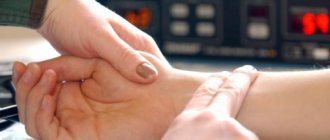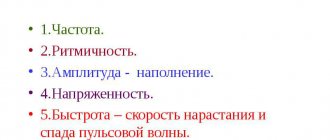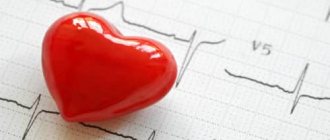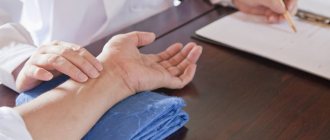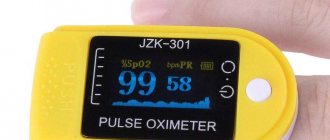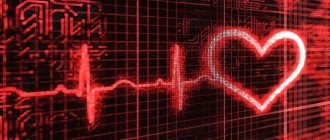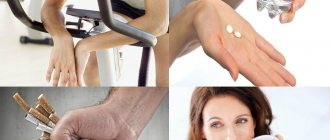Express assessment of the state of the central nervous system (CNS)
Stimulant medications, psychoactive substances (strong tea, coffee, alcohol, nicotine from smoking cigarettes), after their use, noticeably affect the heart rate.
Single-stage test
First, rest standing, without moving for 3 minutes. Then the heart rate is measured for one minute. Next, perform 20 deep squats in 30 seconds and immediately calculate your heart rate for one minute. When assessing, the magnitude of the increase in heart rate after physical activity is determined as a percentage of the initial heart rate.
The emotional state should be equal (without high adrenaline). Values up to 20% indicate an excellent response of the cardiovascular system to physical activity, from 21 to 40% – good, from 41 to 65% – satisfactory, from 66 to 75% – poor. Determination of the time for heart rate recovery to the initial frequency after 20 squats in 30 seconds: 1-2 minutes - excellent, 2-3 minutes. - Fine.
Staircase test to assess the performance of the cardiovascular system
You need to climb four floors up (at a normal pace and without stopping), without using your hands, without touching the railings. Stop at the site and count your pulse. Heart rate less than 100 beats/min is an excellent indicator, 100-120 is good, 120-140 is satisfactory, above 140 is bad. This simple step test is ideal for quickly measuring cardiovascular endurance.
Pulse according to Carlisle (determining the level of body tension during physical activity)
The pulse is counted three times in 10 seconds (P1): immediately after the load, then from the 30th to 40th second (P2) and from the 60th to 70th second (P3). After this, you need to add P1 P2 P3. The closer the pulse sum is to the number 90, the fewer reserves the body has left.
https://www.youtube.com/watch?v=ytcopyrightru
Ruffier index (dynamic load tolerance, option)
Measure the pulse in a sitting position (P1, after a 5-minute quiet state in a sitting position, count for 1 minute), then perform 30 deep squats for 45 seconds and immediately count the pulse while standing (P2, for 30 seconds), and then – after a minute of rest (P3, for 30 s). The index is assessed using the formula: I = [(P1 P2 P3) - 200] / 10
The index for athletes and healthy youth is assessed: less than 1 - excellent, 1-5 - good, 6-10 - satisfactory, 11-15 - weak, 15 - unsatisfactory.
For non-athletes and at the age of 40-50 years: 0-5 – excellent; 6-10 – good; 11-15 – satisfactory (heart failure); 16 and more – bad.
Orthostatic test (level of vegetative-vascular stability, reaction of the cardiovascular system to load when changing body position from horizontal to vertical), option.
Count your pulse in a supine position (P1, initial pulse), after 5-15 minutes of rest on your back, without a high pillow, without experiencing emotional stress.
Next, you need to slowly, without jerking, sit on the edge of the bed/couch, and half a minute later, stand up. After standing quietly for half a minute, begin counting your pulse in a standing position (P2, for 1 minute).
The change in heart rate determines the functional state of the cardiovascular and nervous systems.
The difference (delta) between P1 and P2, not exceeding 20 beats/min, can be considered normal. If the pulse differs from the original by more than 25 beats/min, dizziness appears and blood pressure increases, in which case you should consult a general practitioner or cardiologist.
If the orthotest is carried out after waking up in the morning, then the delta will most likely be higher than in the daytime. The pulse is counted no earlier than five minutes after you wake up and when the heart rate stabilizes.
Too low (systematically less than 40 beats per minute) indicators of “resting heart rate in the morning in bed” may indicate serious heart problems (bradycardia and, in the long term, a possible need for a pacemaker).
Using additional readings measured in a standing position: at the 3rd, 6th, 10th minute, you can build graphs of heart rate and blood pressure versus time and see the dynamics in more detail. It is recommended to measure blood pressure, especially if you are over 40 years old. Normally, during the orthotest, there should be no unpleasant sensations. Changes in heart rate and blood pressure should not exceed 20 beats/min and 10 mmHg, respectively.
In ordinary life, it is often enough to be guided by the P1 and P2 numbers of the incomplete ortho-test, their difference and the absolute values of resting heart rate in order to roughly assess your physical condition in the morning - lying down and getting out of bed. You need to wake up on your own, without an alarm clock (to eliminate the effect of heart palpitations from an unexpected awakening, completely by accident, not falling into the REM sleep phase).
When performing an orthotest in its standard version, one gets up immediately from a horizontal position. But, it is relatively safe only for healthy young people and active athletes. Elderly, sick people, before getting up, need to first sit on the edge of the bed, and only then get up.
To maintain statistics, you need to establish a strictly defined, unchanging order of measurements, for example: P1 – lying down, 5 minutes after waking up from a night’s sleep; P2 (“in the second minute”) – standing up, standing quietly for 1 minute. and, after that, counting the pulse for 1 minute. (in 15 or 30 second intervals to see the dynamics).
Current date 50bpm 35s 7:05 |- – 18 17 | 17 18 17 -| 17 17 16 17 | 7:11 |- 17 |
https://www.youtube.com/watch?v=ytpressru
Explanation. In the example given, pulse P1 = 50 beats/min. A minute after getting up - start recording heart rate from 7:05:30 (within 35 seconds - slowly get up and prepare for measurements; two dashes are the missed first two fifteen-second intervals, while the current date, initial time and first pulse are entered into the notebook ).
Average P2=72 beats/min ((18 17 17 18) / 4 =18; 18*4 =72). A dash on the fourth fifteen-second period - at this moment the previous measurement results were recorded. Avg. Р3=68 beats/min ((17 17 17) / 3 =17; 17*4 =68). Pulsemetry at the fourth minute and later - to further look at the dynamics (to make sure that the transition process has completed and the pulse has stabilized).
Fig.1. Morning orthostatic heart rate test - measurement of pulse in the morning, on the rise (after sleep), in a lying and standing position, for four minutes (15 and 30 second intervals).
The duration of the transition process (the period of time until the pulse stabilizes at a new level, at rest), after a change in body position, is approximately: for men - up to three minutes, for women - up to four minutes.
Orthotest is an objective and reliable indicator of the functional state of the body.
With a difference of 8 to 15 beats/min, the daily load is assessed as average.
If it is more than 15 beats/min, it has been a “hard day” and requires thorough rest.
The resting pulse of a healthy person is considered rhythmic if for every subsequent ten seconds the difference does not differ by more than 1 beat (i.e., the RR intervals differ by no more than 10%) from the previous calculation. Exceeding this difference indicates a currently existing arrhythmia.
The Stange test (while inhaling) is performed in a sitting position. After 5 minutes of rest while sitting, you need to take 2-3 deep breaths and exhale, and then, after taking a full breath, hold your breath, the time is noted from the moment you hold your breath until it stops. 60-90 seconds or more is excellent. 40-55 seconds is the average for untrained people.
The Genchi test (on exhalation) consists of recording the duration of breath holding after a shallow inhalation and maximum exhalation. At the same time, the mouth is closed, the nose is pinched with the fingers. In healthy adults, the breath holding time is at least 25 seconds. This test is easier to perform, safer for health and is carried out much faster than the Stange test.
The Romberg test reveals imbalance in static poses and in a standing position. The vestibular apparatus and cerebellum are checked. Testing is carried out in four stages, with a gradual decrease in the area of support and stability. In all cases, arms are raised forward, fingers spread, eyes closed.
1. First test. You need to stand straight, legs together, arms extended forward, fingers spread, eyes closed. It is necessary to maintain balance for 15 seconds.
2. Second test. Stand up straight, place your feet on the same line (put your heel to your toes), stretch your arms forward, spread your fingers, close your eyes. Maintain balance for 15 seconds.
3. Third test. Stand on one leg, hold the other overhang, arms forward, fingers spread, eyes closed. Stand for 15 seconds. A more complex option is to additionally turn your head left and right, transferring your attention to the same directions (switching, alternate activation of the brain hemispheres). By repeating the test on the other leg, it is possible to numerically (by the difference in digital time indicators) approximately determine the asymmetry in the functioning of the vestibular apparatus, taking into account the disproportions of the musculoskeletal system of the person being tested.
https://www.youtube.com/watch?v=ytcreatorsru
4. Fourth test. Stand in the “swallow” pose with your eyes closed (on one leg, the other leg and torso are horizontal, your head is raised, your arms are spread to the sides). Try to maintain coordination of movements and maintain balance for 15 seconds.
When with a heart rate of 120 you urgently need to call an ambulance
If the heart rate (HR) increases to 120 and is accompanied by symptoms that are dangerous to the blood circulation of the brain or heart, then it is strictly forbidden to take medications or try to use massage, and you should immediately call a doctor. These signs include:
- dizziness, darkening of the eyes, lightheadedness;
- headache attack;
- pressing or squeezing sensations behind the sternum;
- pale skin with cold sweat;
- loss of consciousness;
- increasing difficulty breathing and chest pain.
Influence of physiological characteristics
Heart rate in children is initially higher than in adults. So, for a 2-year-old child in a calm state, a pulse of 115 beats per minute is considered the absolute norm. During physical activity in children, unlike adults, stroke volume (the amount of blood ejected by the heart into the vessels in one contraction), pulse and blood pressure increase more strongly.
Elderly people also have their own characteristics of heart rate readings during exercise. The deterioration of adaptive abilities is largely due to sclerotic changes in the blood vessels. Due to the fact that they become less elastic, peripheral vascular resistance increases. Unlike young people, both systolic and diastolic blood pressure are more likely to increase in old people.
There are adaptation differences depending on gender. In men, blood flow improves to a greater extent due to an increase in stroke volume and to a lesser extent due to an acceleration of heart rate. For this reason, the pulse in men is usually slightly lower (6-8 beats/min) than in women.
A person who is professionally involved in sports has significantly developed adaptive mechanisms. Bradycardia at rest is normal for him. The pulse can be below not only 60, but also 40-50 beats/min.
If 150-180 in an adult
A heart rate of 150 and 180 is not prohibitive for an adult and well-trained person. In order to determine whether the heart is overloaded during exercise, it is necessary to measure the pulse at rest the next day; normally it gradually decreases. If the pulse does not exceed 60 beats, it means that the training plan is correct. When increasing to 75 people are in good physical shape.
All indicators from 75 to 90 are considered satisfactory, and at higher levels you cannot continue to train. Then you need a longer rest and a gradual increase in loads.
Keeping a self-control diary
Self-monitoring is fairly regular monitoring of your health, which is necessary to optimize physical and other activities during the planned training process. All parameters and characteristics are recorded in a personal diary.
Details of the diet, specific practices and procedures used, on one’s own initiative or on the recommendation and prescription of a medical specialist, must be documented, indicating the details necessary for further analysis of the history and understanding the causes of possible pathologies. In total, synergistically, they can dramatically change the state of health and significantly affect sports results, due to attunement or, conversely, imbalance of body systems.
In the “notes and additional information” column, internal and external factors that significantly affect the condition of the body must be indicated. This is, first of all, the current state of the geomagnetic field (“magnetic storms”) and extreme weather conditions, in the form of changes in atmospheric pressure and temperature outside.
Table 2. An example of keeping a self-control diary for an athlete.
| Indicators | Day, month, year, time of day |
| Morning orthostatic test (orthotest) | |
| Heart rate (pulse) before and after exercise | |
| Respiration rate per minute: before and after exercise | |
| Sweating | |
| Body weight before and after training | |
| Well-being | |
| Vital capacity of the lungs | |
| Wrist dynamometry | |
| Dream | |
| Appetite | |
| Mood | |
| Painful sensations | |
| Performance | |
| Desire to train | |
| Sports results | |
| Additional Information |
How to monitor your heart rate
It is best to monitor your heart rate during class using a heart rate monitor or fitness bracelet, as there is a need to stop to count or slow down. Such a sudden cessation of exercise often leads to dizziness and fainting. With a strong heartbeat and shortness of breath, a person often gets lost in the calculations, and repeated measurements already show the wrong indicator.
If there are no sports sensors, then the pulse is measured in the main part of the complex after individual cycles, at the end of the entire workout and at rest. It is also important to carefully monitor sensations in addition to monitoring your heart rate, even if your heart rate is low and there is dizziness or chest tightness, the workout ends.
Contraindications to cardio training
There are few contraindications to exercise in pulse zone No. 1. They are determined individually. Main restrictions:
- Hypertonic disease. The danger is posed by sudden “jumps” in blood pressure. Cardio training for hypertension can be carried out only after proper correction of blood pressure.
- Coronary heart disease (myocardial infarction, angina pectoris). All loads are performed outside the acute period and only with the permission of the attending physician. Physical rehabilitation in patients with coronary artery disease has its own characteristics and deserves a separate article.
- Inflammatory heart diseases. Under a complete ban on exercise in case of endocarditis, myocarditis. Cardio training can only be done after recovery.
Tachycardia during physical activity is not just an unreasonable acceleration of heart rate. This is a complex set of adaptive physiological mechanisms.
For timely load correction and the ability to evaluate the results of cardiovascular training, I recommend keeping a diary of heart rate and blood pressure.
https://www.youtube.com/watch?v=ytadvertiseru
Author of the article: Practicing physician V. O. Chubeiko. Higher medical education (Omsk State Medical University with honors, academic degree: “Candidate of Medical Sciences”).
Treatment for pulse 120 in men and women
To treat an accelerated heart rate of up to 120 beats per minute, the following medications may be prescribed for adult men or women:
- with a calming effect: herbal (Persen, Hawthorn forte) or synthetic (Noofen, Afobazol);
- beta blockers (Betalok, Binelol);
- calcium antagonists (Diltiazem, Verapamil);
- improving nutrition of the heart muscle (Panangin, Riboxin).
For neurosis and neurocirculatory dystonia, medications are often ineffective; physical therapy methods give good results:
- baths with pine needle extract, sage oil, lavender, lemon balm;
- relaxing general or acupressure massage;
- electrophoresis with magnesium on the collar area;
- electrosleep.
When identifying diseases that accelerate the pulse, it is necessary to carry out a full course of their treatment.
A pulse of 120 beats per minute is considered rapid and if detected repeatedly, you need to undergo an examination. The cause may be serious diseases of the heart, nervous system, hormonal imbalance, but tachycardia is often provoked by bad habits and taking medications.
Online calculator for calculating heart rate zones
| Heart rate zone (% of maximum) | Pulse (beats/minute) |
| 100% maximum heart rate | 189 |
| 90% – 100% VO2 zone | 178 – 189 |
| 80% – 90% anaerobic zone | 166 – 178 |
| 70% – 80% aerobic zone | 155 – 166 |
| 60% – 70% beginning of the fat burning zone | 143 – 155 |
| 50% – 60% light activity zone | 132 – 143 |
What is an orthostatic test?
An orthostatic test (or orthostatic test) is a simple way to monitor the condition of your body and its adaptation to stress.
The essence of the test is simple and consists in measuring the pulse while lying down and then standing - the difference between these two measurements can say a lot about the athlete’s form, the degree of fatigue from training, the general condition of the body, and also signal problems in the central nervous and cardiovascular systems.
This test has been used for many years by doctors, athletes, coaches and ordinary people due to its simplicity and accessibility.
Do you need an orthostatic test?
You should definitely pay attention to the orthostatic test if you perform fairly large volumes of training and/or combine training with work and other activities, which means you are not able to recover normally.
If you are a beginner amateur athlete, then the test results will become a clear indicator of your own progress - as your training increases, your resting heart rate will decrease, as will the difference between the lying and standing heart rate.
In addition, orthostatic test results may indicate dehydration and problems with the cardiovascular or nervous systems.
How to carry it out?
The simplest and most convenient option to use is the “Orthostatic Test” function for Polar heart rate monitor users.
In this case, not only do you not need to count anything, but you also do not need to record the data, since it is saved automatically and transferred to your training diary.
If you don't have a heart rate monitor yet, pay attention to test procedure
- You measure your average heart rate per minute at rest, lying down. We recommend doing it in the morning, immediately after waking up, preferably after a day of rest. First, lie still for a few minutes, relax, don’t move – and start measuring!
- Then stand up and take your pulse after 10-15 seconds. Here it is important to get the maximum heart rate value, so you should not measure it for a minute - just multiply the beat frequency for 10 seconds by 6 (or for 15 - by 4). If you are wearing a heart rate monitor, simply note your maximum heart rate after you get up.
- Continue standing and wait until your heart rate “settles down” and stops rising or falling - then take the reading again for a minute.
It is best to always do the test under the same conditions - for example, after a day of rest , immediately after waking up, before you get out of bed. This will help make the results less dependent on external factors.
Some people prefer a simplified version of the test, which measures first your resting heart rate and then your maximum heart rate after standing up.
There is also a laboratory, “passive” method of conducting the test - in which a person is fixed with belts on a special platform, which is first positioned horizontally and then takes a vertical position. In this case, the test results are more “clean”, since the influence of muscles on blood flow and other factors is eliminated. In addition, other measurements are usually taken, such as an electrocardiography procedure.
Benefits of the test
The simple procedure allows you to get stable results, does not involve any exercises or physical activity, and also takes little time.
What do the results mean?
The interpretation of the results here is individual! A change in your indicators in one direction or another is more important than a certain general norm. Some time after starting regular, systematic measurements, you will most likely learn to feel your body more subtly and predict test data.
In general, when conducting a test, you can focus on the following numbers:
- A range from 0 to 12 strikes indicates good training.
- A difference of 13-18 beats indicates a healthy, but untrained person.
- The range from 18 to 25 blows indicates a complete lack of physical fitness.
- If the difference is more than 25 beats, then we can talk about either overwork, or a disease of the cardiovascular system or other health problems.
However, we remind you once again that these figures are indicative.
In any case, we strongly advise you to regularly visit a cardiologist and therapist, as well as get an ECG, regardless of whether you exercise or not, and only then proceed to interpret the test results.
